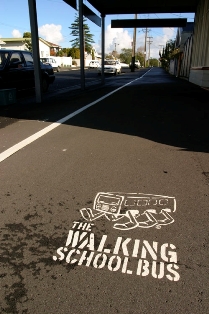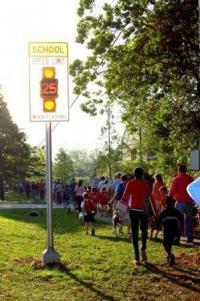
Photo Credit: Mike G. Googly
Walking school buses are a strategy that is becoming more popular across the U.S. These entail one or more adults accompanying groups of children as they walk to and from school. Among communities using this approach are Arlington and Attleboro, MA; Clearwater, Florida; Somerville, New Jersey; Portland, Oregon; Indiana, Pennsylvania; Seattle, Washington; Fairhope, Alabama; and Rapid City, South Dakota.[1] In Chicago, the Active Living by Design partnership, of which The Logan Square Neighborhood Association was a lead partner, began a walking school bus program in 2006.[2] The program collaborated with two public schools (Ames Middle School and McAuliffe Elementary School) and expanded to more elementary schools after its first year of success.

A Walking School Bus in Fairhope, Alabama
An adaptation of the walking school bus model in rural areas is to have school buses drop off students near a school site (approximately one-half mile away) and have an adult lead the students in a walk to school. This approach may not be the best option in all communities, especially those with safety and crime concerns. Such programs have also found it challenging to maintain a corps of parent volunteers.

Children and their Families Walking to School From Bus Drop-Off in Fairhope, Alabama
References:
[1] The Pedestrian and Bicycle Information Center for the Partnership for a Walkable America, in cooperation with the U.S. Department of Transportation, "The Basics: Starting a Walking School Bus," http://www.walkingschoolbus.org (accessed August 4, 2008).
[2] National Center for Safe Routes to School, "SRTS Case Study: Chicago, Illinois, Community Makes it Safe for Children to Walk to School," http://www.saferoutesinfo.org/case_studies/pdfs/IL.chicago.pdf (accessed August 4, 2008).






